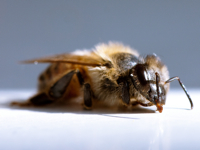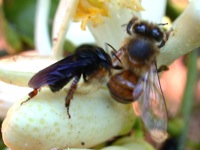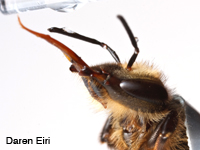Natural and man-made stressors of social bees
-
Evolution of communication

Selective pressures from competitors and predators has shaped social bee communication. Our lab studies multiple bee groups: honey bees, stingless bees, and bumble bees to learn how this communication works and why it may have evolved. read more » -
Honey bee health

Concern is growing over pollinator declines. Our lab examines the effects of natural stressors, such as pathogens (Nosema ceranae), and man-made stressors, such as pesticides, on honey bee health, foraging, flight, and orientation. read more » -
Superorganism inhibitory signaling

What happens if conditions change and the communicated food source becomes depleted, contested, or dangerous? The honey bee stop signal provides inhibition that counteracts the positive feedback of honey bee waggle dances. Using field studies and modeling, we are studying this signal in detail and exploring conditions under which inhibitory signals may evolve. read more » -
Competition and olfactory eavesdropping

We study olfactory eavesdropping in stingless bees and honey bees and examine the advantages of eavesdropping upon competitors and predators. read more » -
Learning, memory, and colony lifestyle

Despite their small brain size and limited number of neurons relative to the central nervous systems of many vertebrates, social insects have evolved sophisticated learning and memory abilities and are therefore important models for animal cognition. However, these abilities can be impaired by field-realistic exposure to pesticides and other man-made stressors. read more »
Learn more about the study of Behavioral Ecology at UCSD.
Translate this website into over 100 languages! Please click on Google Translate and copy and paste this URL https://labs.biology.ucsd.edu/nieh/index.html Then select the language you would like and click on the weblink in the translation box. You can also view an archived version of this page in Spanish, Vietnamese, Portuguese, Simplified Chinese, Swahili, Arabic, or Filipino.
Help support research on honey bee declines. Please visit our online donation website.




